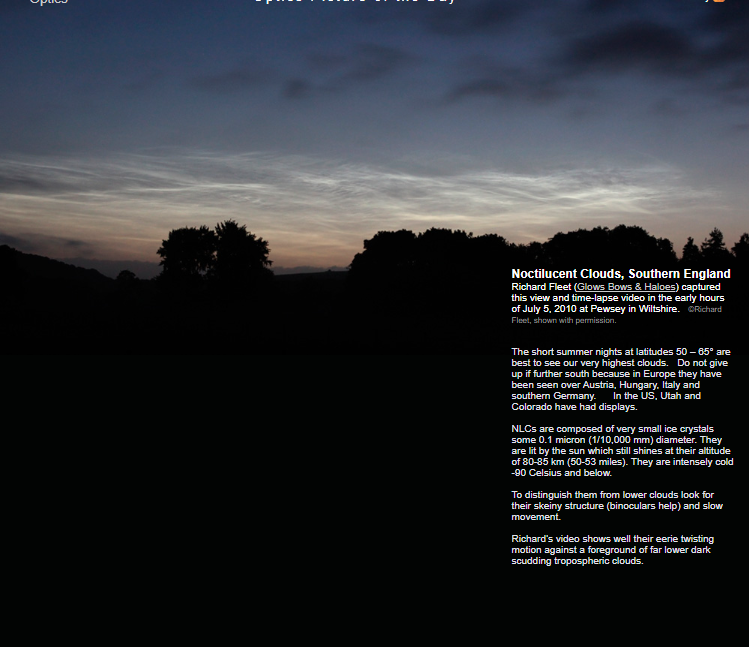S England Noctilucents
Exploring the Enigmatic Noctilucent Clouds in Southern England
Noctilucent clouds, commonly known as NLCs, are a mesmerizing sight that can be observed during the short summer nights at latitudes 50 – 65°. However, even if you find yourself further south, there is still a chance to witness these ethereal clouds in Europe, particularly in countries like Austria, Hungary, Italy, and southern Germany. In the United States, states such as Utah and Colorado have also reported sightings of these elusive clouds.
What makes NLCs so captivating is their composition. These clouds are made up of minuscule ice crystals, measuring a mere 0.1 micron (1/10,000 mm) in diameter. Despite their tiny size, they are still able to reflect sunlight, which reaches their lofty altitude of 80-85 km (50-53 miles) above the Earth's surface. These clouds exist at such extreme heights that they remain illuminated even during the darkest hours of the night. However, it is worth noting that they are intensely cold, with temperatures dropping below -90 degrees Celsius.
Distinguishing NLCs from lower clouds can be a fascinating challenge. One characteristic to look out for is their delicate and intricate structure, which can appear skeiny or wispy. Using binoculars can enhance the viewing experience and aid in observing their unique features. Additionally, NLCs exhibit a slow movement compared to other cloud formations. Their unhurried motion adds to their mystique, as they gracefully twist and shift against a backdrop of lower dark scudding tropospheric clouds.
To gain a more immersive understanding of Noctilucent clouds, Richard Fleet's captivating time-lapse video provides a glimpse into their mesmerizing behavior. Filmed in the early hours of July 5, 2010, at Pewsey in Wiltshire, Southern England, the video showcases the eerie twisting motion of NLCs against a foreground of lower tropospheric clouds. It serves as a reminder of the ethereal beauty that can be found in the night sky.
While NLCs are a captivating phenomenon, it is essential to be aware of their fleeting nature. These clouds are typically observed during the summer months, and their visibility is influenced by various factors such as weather conditions, latitude, and local light pollution. Therefore, it is crucial to seize any opportunity to witness these elusive clouds when they make their appearance.
If you're fortunate enough to witness NLCs, take a moment to immerse yourself in their enchanting presence. Marvel at their delicate structure and the slow dance they perform in the night sky. Allow yourself to be captivated by their otherworldly beauty, as these transient clouds offer a glimpse into the wonders of our atmosphere.
Please note that this article has been automatically converted from the old site and may not appear as intended. However, we hope that it still provides valuable insights into the captivating nature of Noctilucent clouds.

Noctilucent Clouds, Southern England
Richard Fleet (Glows Bows & Haloes) captured this view and time-lapse video in the early hours of July 5, 2010 at Pewsey in Wiltshire. ©Richard Fleet, shown with permission.
The short summer nights at latitudes 50 – 65° are best to see our very highest clouds. Do not give up if further south because in Europe they have been seen over Austria, Hungary, Italy and southern Germany. In the US, Utah and Colorado have had displays.
NLCs are composed of very small ice crystals some 0.1 micron (1/10,000 mm) diameter. They are lit by the sun which still shines at their altitude of 80-85 km (50-53 miles). They are intensely cold -90 Celsius and below.
To distinguish them from lower clouds look for their skeiny structure (binoculars help) and slow movement.
Richard’s video shows well their eerie twisting motion against a foreground of far lower dark scudding tropospheric clouds.
Note: this article has been automatically converted from the old site and may not appear as intended. You can find the original article here.
Reference Atmospheric Optics
If you use any of the definitions, information, or data presented on Atmospheric Optics, please copy the link or reference below to properly credit us as the reference source. Thank you!
-
<a href="https://atoptics.co.uk/blog/s-england-noctilucents/">S England Noctilucents</a>
-
"S England Noctilucents". Atmospheric Optics. Accessed on December 23, 2024. https://atoptics.co.uk/blog/s-england-noctilucents/.
-
"S England Noctilucents". Atmospheric Optics, https://atoptics.co.uk/blog/s-england-noctilucents/. Accessed 23 December, 2024
-
S England Noctilucents. Atmospheric Optics. Retrieved from https://atoptics.co.uk/blog/s-england-noctilucents/.